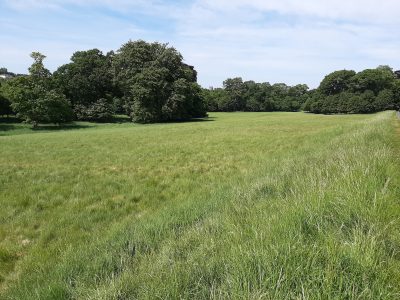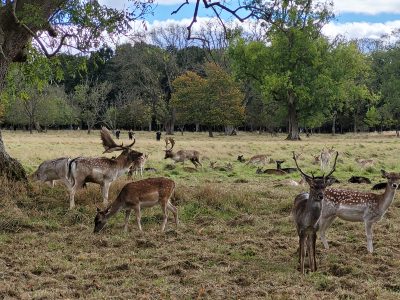January 14th 2023
I have written before about the need for rewilding the Phoenix Park, Dublin’s largest urban green space. I bemoan the intensive level of management by the Office of Public Works which minimises it’s biodiversity value: dead or fallen trees cleared away, poor management of woodland areas and a continued emphasis on replanting non-native trees. I also criticised the very low diversity of flowers in the expansive meadows which in turn leads to nearly no flying insects, even in high summer.
I had long wondered why this was; the meadows are old and have never been fertilised or sprayed with herbicides. If they were on a farm anywhere else they would be full of orchids, bees, wild flowers and butterflies. Yet, they are practically barren. I had thought that perhaps the isolation of the Park – being surrounded by concrete and tarmac – meant there was no source of seeds for plants to colonise the grasslands. I therefore thought that seeding the grasslands with native wildflowers would be the solution, an idea I put to the Park superintendent a few years back. The response was that there would be no point in doing this as the deer would eat them, an idea I dismissed at the time but which I have to admit now is correct.
There are few areas of the Park which are out of bounds to the fallow deer, which were brought from Britain in the 1600s by the Duke of Ormond for his hunting pleasure. Where they exist, such as near the visitor centre with its popular café and children’s playground, grassy areas are dominated in summer by tall stands of cow parsley and hogweed, along with vetches and buttercups. Hogweed and cow parsley are among Ireland’s commonest meadow flowers and are wonderful for insects but their names also hint at their nutritional value for livestock. And they are all but absent on the vast plains of the Park which are dominated by a handful of grasses with low biodiversity. It is now clear to me that is not due to a lack of seeds but because the deer are eating them, just as the superintendent had said.

Expanses of near-barren grassland should be full of flowers and insects
The fallow deer are not a native species. Their original range was around the Mediterranean basin and present-day Turkey but were introduced widely across Western Europe by the Romans and later in the Middle Ages to populate royal hunting parks, including in Ireland and Britain.
Today there are about 600 deer in the Park, a number that is managed through culling every autumn. They are immensely popular, the herds of deer are frequently ringed with people, many getting too close. Against the warnings of the Park staff, people feed them carrots and crisps and have even taken to leaving their post-Halloween pumpkins for them. But far from being an important part of our biodiversity the deer are, in fact, a major pressure on it and are holding the Park back from reaching its potential. I think it’s now time to get rid of them.
Deer across Ireland are increasingly a problem. Although there is still no data to estimate their numbers, it is clear that these are increasing. In the 1970s deer were rare but legal protection under the Wildlife Act, along with perhaps a decline in hunting and no natural predators, has meant there are now few areas of Ireland without a significant population. With the exception of the red deer in Killarney, which has been in Ireland at least since the Neolithic Age 5,000 years ago (although there are studies suggesting it was also introduced by people) all of these deer are alien species. These are mostly Sika deer, brought from Japan in the 1860s, and which are a routine sight on the Dublin or Wicklow hills but the fallow deer are also abundant in parts of the Midlands, while red deer from Scottish stock are found in Donegal and parts of the eastern lowlands, such as Co. Meath.
Prominent foresters in Ireland decry the abundance of deer which inhibit, or prevent completely, the growth of trees, whether that is planted saplings, which need to be protected with plastic tubes or high fences, or seedlings that have naturally generated. Along with the hundreds of thousands of sheep which crowd the hills, the deer are a serious limiting factor in meeting our ambition to drastically expand forest cover – regardless of whether that is for purely nature or commercial purposes.
This can be seen in the Phoenix Park where trees are unable to seed themselves as tasty new leaves are quickly sought out by the hungry ungulates. Leaves are more nutritious than grass, which explains why the grasslands do not appear overgrazed (they still look quite tussocky even in winter) and why the canopies of trees form a near perfect straight line approximately two metres above the ground – the maximum height to which the deer can reach. Every shoot and bud within access is quickly devoured.

Fallow deer – time to go
But while the impacts of deer on tree regeneration have been acknowledged, the impacts on grassland biodiversity are much less so. But in seeking out tasty broadleaves the alien deer have left the Park a near-dead zone for plant and insect life.
Removing the deer from the Park would not be popular, at least at first. But I think few Dubliners realise the price that we pay for having them. They are the reason you can’t walk on a summer’s day through a flower rich meadow humming with bees, grasshoppers and butterflies. They are, at least partly, the reason why there is no new native woodland in the Park. They are the reason why the Park is surprisingly poor for nesting song birds (too much grazing means too little scrub meaning to few nesting places).
We don’t need to get rid of deer entirely. However it is clear that 600 is too high a number. And maybe the Park could support a small herd of native red deer instead of the alien fallow? Celebrating the fallow deer is hardly any different to saying we should keep the rhododendron in Killarney because they are pretty. In fact, the deer contribute to a Disneyfication of nature that has little to do with biodiversity.
Urban green spaces need to be a part of our response to the biodiversity and climate emergency. This includes their role in educating people as to what biodiversity is, why it is important and the joy in reconnecting with that – rather than the potted and stunted version we get in places like the Phoenix Park. Getting rid of the fallow deer in the Park would be an important step on this road.
Pádraic Fogarty
There is a public consultation on deer management in Ireland which is open until February 10th:
gov.ie – Public Consultation on the Management of Deer in Ireland (www.gov.ie)